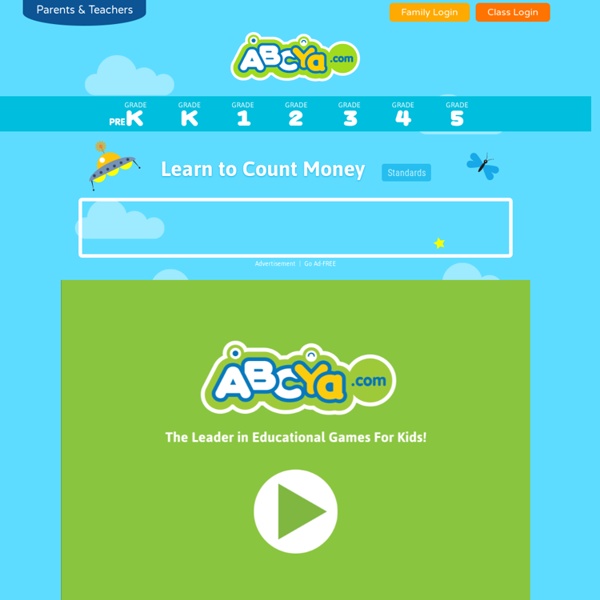Uppercase and Lowercase Letter Matching for Kids
ABCya is the leader in free educational computer games and mobile apps for kids. The innovation of a grade school teacher, ABCya is an award-winning destination for elementary students that offers hundreds of fun, engaging learning activities. Millions of kids, parents, and teachers visit ABCya.com each month, playing over 1 billion games last year. Apple, The New York Times, USA Today, Parents Magazine and Scholastic, to name just a few, have featured ABCya’s popular educational games. ABCya’s award-winning Preschool computer games and apps are conceived and realized under the direction of a certified technology education teacher, and have been trusted by parents and teachers for ten years.
Learning Coins for Elementary Children
ABCya is the leader in free educational computer games and mobile apps for kids. The innovation of a grade school teacher, ABCya is an award-winning destination for elementary students that offers hundreds of fun, engaging learning activities. Millions of kids, parents, and teachers visit ABCya.com each month, playing over 1 billion games last year. Apple, The New York Times, USA Today, Parents Magazine and Scholastic, to name just a few, have featured ABCya’s popular educational games. ABCya’s award-winning Preschool computer games and apps are conceived and realized under the direction of a certified technology education teacher, and have been trusted by parents and teachers for ten years.
Academics / Eight Mathematical Practices
Explanation of the Eight Mathematical Practices The Standards for Mathematical Practice describe varieties of expertise that mathematics educators at all levels should seek to develop in their students. These practices rest on important “processes and proficiencies” with longstanding importance in mathematics education. The first of these are the NCTM process standards of problem solving, reasoning and proof, communication, representation, and connections. The second are the strands of mathematical proficiency specified in the National Research Council’s report Adding It Up: adaptive reasoning, strategic competence, conceptual understanding (comprehension of mathematical concepts, operations and relations), procedural fluency (skill in carrying out procedures flexibly, accurately, efficiently and appropriately), and productive disposition (habitual inclination to see mathematics as sensible, useful, and worthwhile, coupled with a belief in diligence and one’s own efficacy). But really.
Categories of Disability Under IDEA
March 2012 A legacy resource from NICHCY The nation’s special education law is called the Individuals with Disabilities Education Act, or IDEA. As part of making special education and related services available to children with disabilities in the public schools, IDEA defines the term “child with a disability.” That definition includes specific disability terms, which are also defined by IDEA, as this webpage describes.
Using Minecraft to teach Math Literacy
You’ve probably heard of the game Minecraft – millions of children around the world play it – but did you know that it can help teach math skills? I didn’t. When my 7-year-old asked me to download Minecraft for him, I checked it out online first, and what I read astounded me.
Autism Facts
The Centers for Disease Control and Prevention (CDC) indicate that approximately 1 in 68 American children are on the autism spectrum. More specifically, it’s estimated that 1 in 42 boys, and 1 in 189 girls are diagnosed with autism in the US. This new estimate is roughly 30 percent higher than previous estimates reported in 2012 of 1 in 88 children
NKC Addition Blast Off
Skip to main content NKC Addition Blast Off › Text Only Site
Functional Reading Tasks and IEP Goals - Autism Classroom Resources
Functional reading skills are critical for students on the spectrum and other disabilities. Reading is something that needs to be used and even students who are not book readers can often learn single sight words that can impact their independence in their communities. We need to make sure that our students have the ability to function as independently as possible and that includes being able to read signs, grocery ads, words on the job and words on menus. The Thanksgiving Menu Math that I talked about in an earlier post is an example of a task that includes both math and some functional reading.
Math Play - Free Online Math Games
Transition to Adulthood
Link-checked, October 2014A legacy resource from NICHCY About transition in Spanish | Sobre transición en español Life is full of transitions, and one of the more remarkable ones occurs when we get ready to leave high school and go out in the world as young adults.
Special Education Lesson Plans
For Kindergarten to Second Grade Cave Club Introduction - Student will learn about prehistoric time through hands-on learning activities and other creative art projects.Classroom Etiquette - Raising your hand, asking "please", not calling out without be called on, listening and respecting other classmates ideas.Color Sorting - Sorting colors and shapes.Counting with Dr. Seuss - The student will use numbers and count.Decimal Values and Money - The students will use coins to arrive at the designated total marked on the envelope.Exceptional Children Class Lesson - Students will use their prior knowledge of The Grouchy Ladybug to help them create a mathematical story problem using the grouchy ladybug and the aphids that are to be eaten.How do I feel? - The overall subject would be "Sometimes I feel..."



